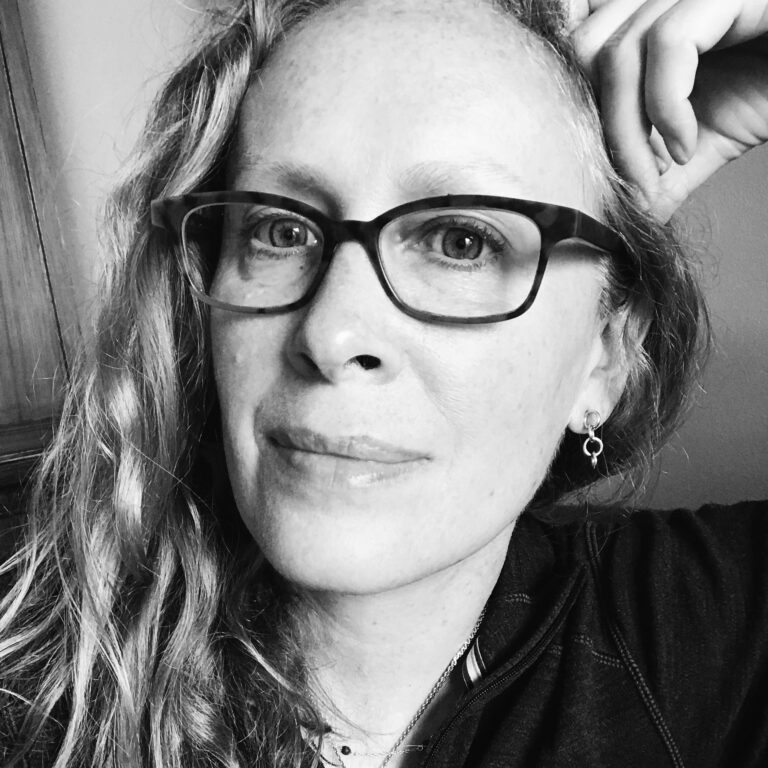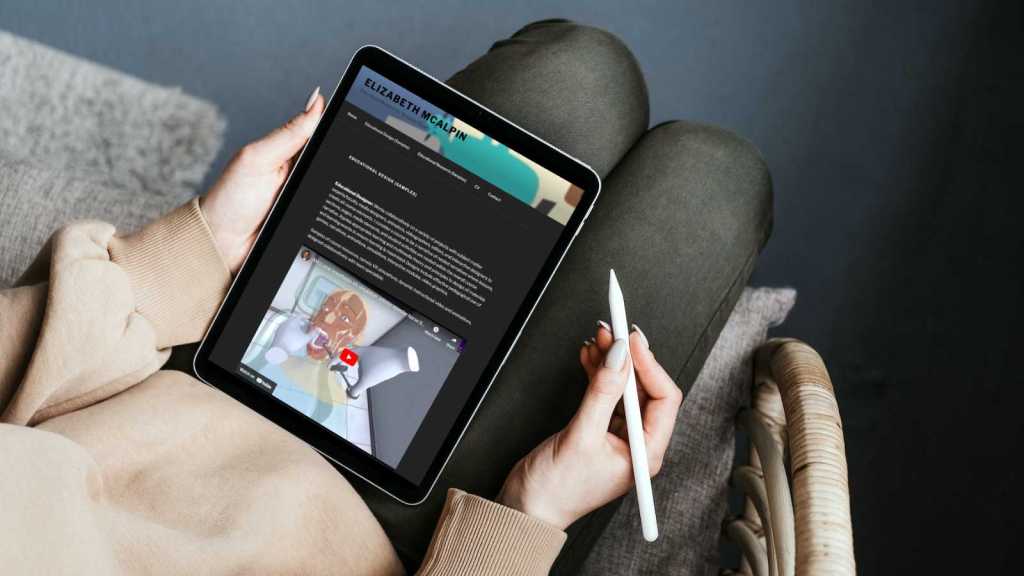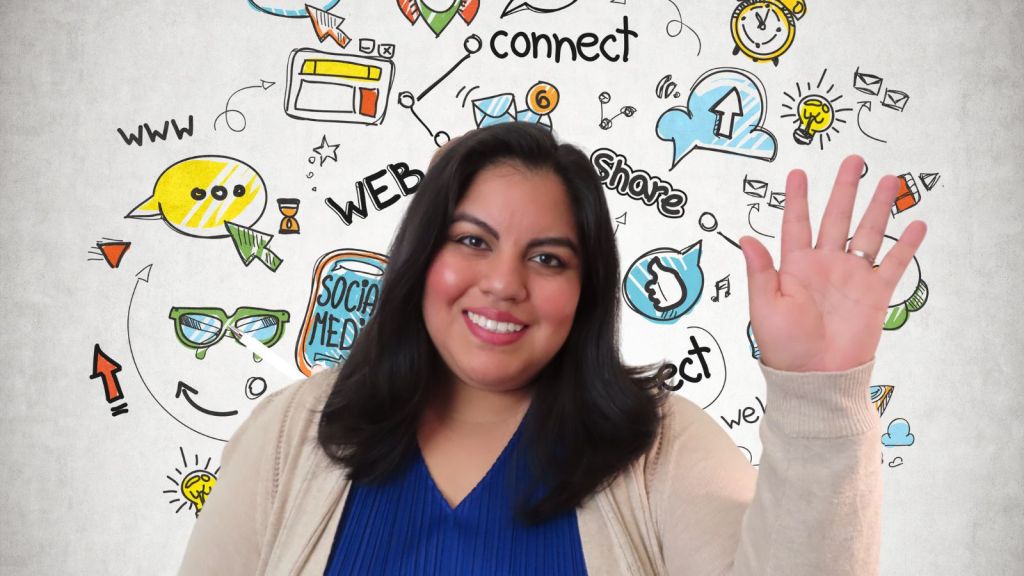Educational Technology and Personal Academic Websites with Dr. Elizabeth McAplin

Ready for a conversation about educational technology, artificial intelligence, and personal academic websites? The 2024 season of The Social Academic is here.
Meet my featured interview guest, Director of Educational Research Technology at New York University, Dr. Elizabeth McAplin. Read, watch, or listen to this episode of The Social Academic.
Subscribe to The Social Academic blog.
The form above subscribes you to new posts published on The Social Academic blog.
Want emails from Jennifer about building your online presence? Subscribe to her email list.
Looking for the podcast? Subscribe on Spotify.
Prefer to watch videos? Subscribe on YouTube.
In this interview
Meet Elizabeth
Jennifer: Hi everyone, my name is Jennifer van Alstyne. Welcome to the new season of The Social Academic. This blog, podcast, and YouTube channel is about managing your online presence in academia. Today we’re gonna be talking about teaching and educational resources.
I’m delighted to introduce my guest to you, Dr. Elizabeth McAplin, who is Director of Educational Research Technology at New York University. Elizabeth, thanks so much for joining me today. Would you please introduce yourself and tell us a little bit about your role at NYU?
Elizabeth: Sure. I’m Director of Educational Technology Research at NYU. I’ve been in this role a little over 7 years now, and at NYU for almost 10 years. I did my PhD at NYU and a MA in Educational Technology at NYU so I have a very long history with NYU.
When I was a student there and worked, I had multiple hats: student, alumni, faculty, and administrator.
Jennifer: Wow.
Elizabeth: Yup, all of them. I was the face of NYU. My role there specifically is to collaborate with faculty who are looking to make pedagogical changes to their courses usually involving some sort of media or technology.
We had a very large provostial push years ago to encourage faculty to start using technology, trying it out. And seeing how well that could enhance their courses and make things better and easier for themselves as well as their students.
I’ll work with them in part sometimes to develop a technology. Sometimes it might be a virtual reality project that they might want to use in their course or program. As well as conduct scholarly research to see how well that is impacting student learning in their classroom or program. We aim to publish those findings as well.
I’m a central resource. I work with all schools and departments at NYU.
Creating her university-hosted personal academic website

Jennifer: That is amazing. Because you’ve been at NYU for so long, you were a student there, you’ve worked there, and now you’re a director there. I’m curious. You have an internal personal academic website [hosted by NYU]. Is that something you created when you were a student? Or, in your newer role?
Elizabeth: No, I created it during a time when I was both a student and in my current role. I was finishing my PhD while I was still a Director.
I created it not for the purpose of my own portfolio site. I do have a presence at NYU that shows my service within the structure of Research, Instruction, and Technology which is my department, within the larger umbrella of NYU IT. [That presence] does get a little bit lost sometimes in that filter. But it is there. It doesn’t describe me personally, it describes my service to faculty and to the university. It’s not focused on me per se.
The portfolio site is to showcase some of the work I’ve done in the past, mainly at NYU. It does also list my CV, prior work experience as well as teaching experience and the like. In the event life changes, I like to have something available and ready to show.
Jennifer: I love that. When I was exploring your site it was fun for me to see the different types of videos you were posting about educational technology projects you were working on and collaborating with faculty. I like that even though this is a portfolio site, it sounds like maybe a ‘just in case’ site? That it was helping me prepare for this interview and get to know a little bit more about you. At what point did you create that website?
Elizabeth: That was many years ago. It’s hosted through NYU. NYU provides faculty a WordPress service just for that. Sometimes they use it to create a portfolio for grants they’ve received or want to receive. They can provide that to their grant funders. It’s another way to showcase the work that gets done.
It’s an internally managed WordPress hosting site. It’s not something I pay for externally. All faculty have that available to them [at NYU].
Jennifer: Did NYU encourage you to create a website? Or was it something you learned about and then decided to make yourself?
Elizabeth: I think when I knew the service was available, and I was teaching there as well, I decided it was a good idea and why not? I mean, if it’s free and I don’t have to pay for it, there’s no non-incentive not to do it, haha.
Subscribe to The Social Academic blog.
The form above subscribes you to new posts published on The Social Academic blog.
Want emails from Jennifer about building your online presence? Subscribe to her email list.
Looking for the podcast? Subscribe on Spotify.
Prefer to watch videos? Subscribe on YouTube.
Videos for your personal academic website portfolio

Jennifer: Your portfolio had a nice list of videos where you’ve collaborated with faculty to create resources and technologies for their classrooms. Can you tell me about one of the videos that you were excited to share on your website?
Elizabeth: Before I was a Director of Research, I was a Director that oversaw a very large team of instructional designers and media producers. Our role was to create a lot of this content for faculty to be used in their courses. I learned a great deal about each faculty member I worked with and their particular expertise. It’s kind of a wonderful way to learn more, because I love learning. And to create and produce those videos.
Most of those [videos] were created with a team of people. They would be scripted, prepared, and imagery selected for them ahead of time. They were very well planned out videos that were used in their courses.
Or they were videos demonstrating a virtual reality project. I think one of the 1st videos in the list is something more recent I’ve worked on with faculty: a virtual reality project to help teach students how to deliver local anesthesia in a dental setting. That describes what that project is about. The other videos are more content related to courses specifically.
They’re just fascinating and visually engaging pieces of work. We did a lot of things! A lot of interactive pieces: videos, games, simulations, etc.
Jennifer: That is so cool! And I love that there’s support at NYU for faculty who are looking to introduce those newer technologies into their pedagogy, into their teaching.
Subscribe to The Social Academic blog.
The form above subscribes you to new posts published on The Social Academic blog.
Want emails from Jennifer about building your online presence? Subscribe to her email list.
Looking for the podcast? Subscribe on Spotify.
Prefer to watch videos? Subscribe on YouTube.
Artificial intelligence in the university classroom

Jennifer: I’m curious. What technologies are faculty curious about exploring? I’m coming from literature as a field. There’s newer augmented reality [AR] or virtual reality [VR] technology that can be introduced into that. Most faculty just aren’t aware of it. So I’m curious, what are faculty at NYU curious about learning now?
Elizabeth: Artificial intelligence. It’s a really big topic right now because it has so many unknowns.
I think there’s still a lot of faculty that are hesitant to use a lot of technology. I think since COVID when faculty had to go online during that time period, that was a big change for them. It did kind of give them that opportunity to learn more about technologies they could use moving forward.
There’s giving a Zoom presentation, learning how to present, use technologies within Zoom for their classes, making hybrid courses or fully online versions of them. Learning how to create better videos for their courses.
Not relying so much on lecture as being used for the time in the classroom anymore. Pulling the lecture out, making that as a video or something, and using the classroom for more discussion or interactive uses of the time with their students.
Jennifer: That is so cool.
Elizabeth: It’s such a precious amount of time.
And then, there’s a handful of faculty very interested in virtual reality and augmented reality. Those are mainly in the sciences and medical fields.
And now, artificial intelligence is the biggest buzz at the university. How are faculty going to manage using artificial intelligence, ChatGPT, in a productive and constructive way as opposed to ways that students want to write their papers with.
Jennifer: It’s kind of like a shift in how we think about artificial intelligence in the classroom from fear-based to how can it be a part of it in a meaningful way?
What are your thoughts on it? How are you feeling about artificial intelligence and pedagogy?
Elizabeth: I think there can be a lot of great uses of it, as long as it’s well planned out. There are efficiencies to things like using ChatGPT that we didn’t have before. That can be wonderful.
Even doing literature reviews and such through ChatGPT can help speed up that process. We didn’t have to go to a library before to do a lot of research on articles because now they’re all digitized. We can do that through an online library system.
It just gets a little bit closer to making things more efficient. Maybe we’ll have more doctoral students coming out of it. I’m not sure.
There’s always going to be pros and cons for whatever technology comes before us. We have to acknowledge it. We have to understand what are the risks? What are the affordances? And work with that. That’s always going to be the case.
Just like with a calculator, one of those tools that came out and people said, “You won’t have to learn math anymore because you can just use a calculator.” Regardless of all that, yes, we will still turn to our calculators to make sure we’re right in our math.
It’s not a new problem, and it’s not a new risk. I think some of it comes down to making sure when we’re using these tools, we’re not also putting our students at risk like with identifiable information or grades, things like that. It’s a constant conversation to have with faculty on best uses and practices of these technologies and tools. And to keep monitoring those risks and the things that are gonna come up. They’re going to come up. They always will.
When students get very stressed out and are under pressure, they’re more apt to want to cheat. Or have something, or someone, help them get the work done. So reviewing how much work we’re imposing on our students, or understanding that their social lives are taking a precedence they need to dial back to focus on their academic careers. It’s always a balance: is it the student’s problem? Or, is it our problem? And how do we find a happy medium in between?
Jennifer: I really like that. It’s a beautiful point. When I was a student my parents had just passed away. I was working so hard. There were times I struggled to keep up. My teachers’ empathy for understanding what I was going through, even just a little bit made it feel like a safe place in the classroom, and made me excited to learn (even if I was a little bit behind in some areas). So I loved what you just said.
Subscribe to The Social Academic blog.
The form above subscribes you to new posts published on The Social Academic blog.
Want emails from Jennifer about building your online presence? Subscribe to her email list.
Looking for the podcast? Subscribe on Spotify.
Prefer to watch videos? Subscribe on YouTube.
Virtual reality and haptics in teaching

Which of the technologies you just share with me are you most excited about? You talked about AR, VR, artificial intelligence, games. Which of those kinds of forms of teaching excites you?
Elizabeth: I’ve been working so much in virtual reality recently in the past few years, so I guess that’s the most exciting.
I’ve been working with 1 faculty member for almost 10 years. We just keep evolving resources for her course, which is really large, almost 400 students in her course. The virtual reality project we had for her, we keep trying to find ways to improve the experience overall. We’ve just gotten into working with faculty in the School of Engineering on how to create custom haptics for that virtual reality simulation.
Jennifer: Would you explain haptics for us?
Elizabeth: A virtual reality out of the box headset comes with the headset and 2 hand controllers. When you’re trying to learn a procedure that involves medical instruments like a syringe or a scalpel if you’re doing surgery, you want to know and feel what that device is like as you are performing the procedure. It’s not just cognitive. It’s tactile. It’s procedural. It has multiple learning and practice components to it.
An out of the box hand controller is not particularly authentic to actually holding a syringe and actually practicing learning that procedure. Working with engineers, they developed a 3D printed syringe and connected that to a haptic device that now students can pick up and actually feel something that’s more authentic to that experience as they are in a virtual reality simulation in going through those procedural steps.
It’s never going to replace working on an actual patient. We’re trying to prepare them to get as close as possible to a real patient experience before they work with a patient because there are so many risks involved in working with a real patient. So that’s the impetus behind that. It’s an ongoing process. We keep learning and we keep trying to make things better. That’s for us, part of the learning process as well. And that’s what’s exciting.
Jennifer: That sounds so exciting. And I love it’s been an ongoing project and exploration over 10 years to improve the teaching and tools in that course.
Jennifer on sharing the resources you create online

Jennifer: One of the things I wanted to chat about for faculty who might be listening to this, is that when you do create educational resources or tools like this, it would be great to share on your personal academic website and on social media.
These tools don’t just help your students and other faculty at your university. They might help or inspire faculty across the world. I want you to know when you do take time to share those educational resources that you’ve made in a new way, in a way that’s accessible for people not directly in your classroom or talking with you at a conference 1-on-1. You can actually help more people with the hard work you’ve already done just by sharing it.
There’s so many things you can share on your personal website related to teaching. I thought I’d list a few for those listening: your syllabi, course descriptions, any videos, or tools like PDF resources or guides. That can go on your personal academic website. If you find that it’s helpful for you or your students, I’ve had professor clients who actually create lists of internal resources and external resources at their university that they regularly share with not just one class, but multiple. Putting that on their personal website creates a kind of home for it where your students can go to find those resources when it makes sense for them.
I want you to know that your website can be a portfolio. And that portfolio can be for the job market, it can be for grants like Dr. McAplin said. It can also be for your students. There’s so many ways to share the amazing teaching and educating you do online. I want you to not hide from that if you have resources to share.
Subscribe to The Social Academic blog.
The form above subscribes you to new posts published on The Social Academic blog.
Want emails from Jennifer about building your online presence? Subscribe to her email list.
Looking for the podcast? Subscribe on Spotify.
Prefer to watch videos? Subscribe on YouTube.
‘We’re proud of the work that was done’

Jennifer: Dr. McAplin, why did you actually choose to share the videos on your website? I think that’s the step a lot of people are missing. They create things, but they don’t always decide to share them. What prompted you to actually share the videos and the resources you helped create?
Elizabeth: We’re proud of the work that was done. We want to show what’s possible. We’re not creating things for National Geographic or some NOVA high-production value thing. It doesn’t have to be that. But we took as much time and care as we possibly could with very little budget at all to make these resources. So it’s just to show examples of what’s possible and change a little bit the narrative. We get comfortable lecturing, but when we don’t have a visual idea for our students for what we’re talking about as we’re talking about it…we don’t want to cause a cognitive dissonance with that information either. Thinking carefully about the words with the imagery or short clips of documentaries or films that go along with what we’re saying to describe as examples of what we’re talking about. As long as they’re relevant and not overdoing it, I think it’s a good way to connect what we say with our eyes. We process these two things simultaneously, so we have that cognitive ability to do so, and we should take advantage of that ability.
What we try to encourage with faculty and to try and make it a more enriching experience for our students.
Jennifer: That is beautiful. I’m so glad we got to talk about this today. Elizabeth, is there anything else you’d like to add about your website, or about the amazing work you do at NYU?
Elizabeth: I list [on my website] that I do workshops at the university. I get asked to do talks within the university. Those are important things to share, like this conversation. We have something at NYU called Teach Talks through the Provost department and there’s some other departments that do similar things, that connect with faculty to talk about things like their assessment practices, pedagogical practices. We haven’t really had one that talks about their research. That might be a missing link we could try to fill, which is more what my area is, on the research end.
These are great resources for faculty to connect with other faculty, to learn about more ways to do things, to inspire them to do things differently, and to take a leadership role forward in that department. That’s more or less what I provide on my website.
Jennifer: That’s amazing. I’m so glad you have your website. And, that I was able to explore it so we could have this conversation today.
It makes such a difference when people are open to sharing a little bit more about themselves. So I’m happy you were open to coming on The Social Academic to talk with me. Anything else you’d like to add?
Elizabeth: If anyone has any questions, I’m available to answer them.
Jennifer: Wonderful. Well thank you so much for listening to this new episode of The Social Academic. Be sure to share it with a friend if you think they’d find it helpful. And, be sure to subscribe so you don’t miss the next episode.
I’m Jennifer van Alstyne. I’ve been in conversation with Dr. Elizabeth McAplin. I’m so excited to share this episode with you.
Elizabeth: Thank you Jennifer for asking me to participate.
Jennifer: Thank you!
Subscribe to The Social Academic blog.
The form above subscribes you to new posts published on The Social Academic blog.
Want emails from Jennifer about building your online presence? Subscribe to her email list.
Looking for the podcast? Subscribe on Spotify.
Prefer to watch videos? Subscribe on YouTube.
Bio for Dr. Elizabeth McAplin
Dr. Elizabeth McAlpin is the Director of Educational Technology Research at NYU Information Technology. Her team assists faculty in scholarly research on teaching and learning strategies when enhanced with technology to improve student learning. She holds an undergraduate degree from Denison University, an Ed.M. in instructional technology and media from Teachers College, and an M.A. and Ph.D in educational communication and technology from New York University. In addition to her full-time position, she also teaches as an adjunct at NYU. Her interests include educational technology research, effective educational design, innovative pedagogy and assessment, and educational technology and media for all kinds of learning experiences.
Jennifer van Alstyne View All →
Jennifer van Alstyne is a Peruvian-American poet and communications consultant. She founded The Academic Designer LLC to help professors build a strong online presence for their research, teaching, and leadership. Jennifer’s goal is to help people feel confident sharing their work with the world.
Jennifer’s personal website
https://jennifervanalstyne
The Academic Designer LLC
https://theacademicdesigner.com
